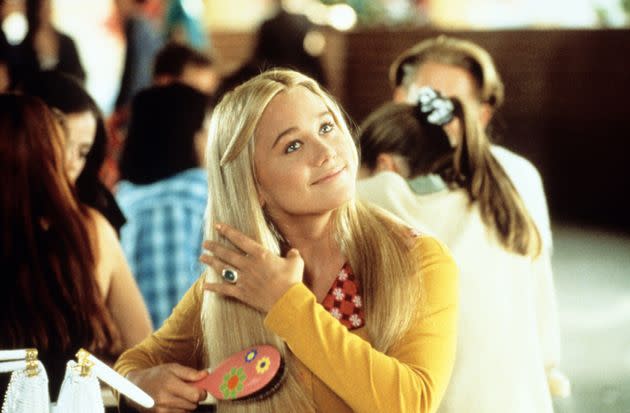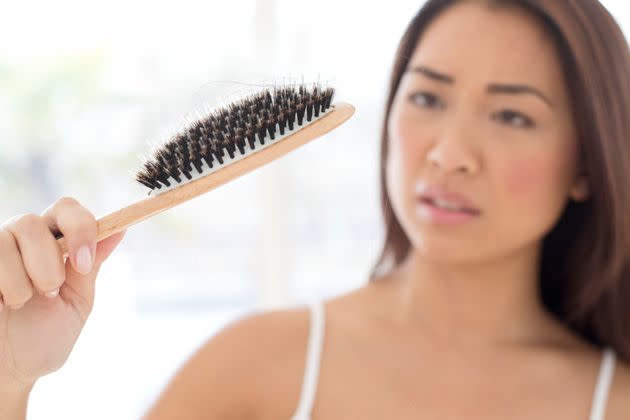Is There Any Truth To The '100 Strokes A Day' Hair-Brushing Rule?
- Oops!Something went wrong.Please try again later.

Hair care is inching toward becoming as popular as skin care. With talk about the “skinification” of hair, brands are coming out with products to aid the health and growth of hair, from scalp scrubs to brushes that claim to stimulate growth.
With all of these products out on the market, are we neglecting the one thing we can do at home virtually for free ― brushing our hair? You may remember the episode of “The Brady Bunch” where Marcia suggested that 100 brush strokes per night kept her hair looking beautiful. But is there any truth to this?
According to the American Academy of Dermatology, that level of dedication may not be necessary. But we spoke with two experts — a trichologist and a dermatologist — who have some good guidelines to follow.
The Benefits Of Brushing Your Hair
There are many positives when it comes to hair-brushing, apart from just removing tangles.
“Brushing your hair gently can stimulate blood circulation beneath the scalp and increase oxygen and nutrient intake of the follicle,” explained trichologist Shab Caspara.
Brushing also helps distribute natural oils to the follicles, said Dr. Jody Levine, a board-certified dermatologist based in New York.
Essentially, Caspara explained, the increased blood circulation and stimulation of the scalp encourage hair growth with a boost of nutrients and oxygen. “Brushing the scalp can also help exfoliate and dislodge any hair growth hindering buildup,” she added.
Levine agreed. “Brushing, when done correctly, can support hair health by increasing blood flow and oil to the scalp, and preventhair loss,” she said.
Here’s Where It Can All Go Wrong
Excessive hair-brushing can cause breakage, thinning and even hair loss, Levine said. A 2009 study concluded that hair loss in women was reduced when they brushed their hair less.
You have to pay attention to your technique, explained Caspara. “Brushing hair incorrectly, like starting at the top and brushing down, can create more tangling, compared to brushing from the ends and working your way up,” she said.
When the hair is wet, it’s very fragile and more susceptible to breakage. “The hydrogen bonds of hair is temporarily broken [when wet], leaving the hair vulnerable to damage,” Caspara explained.
You should also avoid using a brush with sharp bristles if you have a sensitive or sore scalp, Caspara told HuffPost.

How Often Should People Brush Their Hair?
Do all types of hair require brushing? “Yes — however, it is important to consider the type of hair and adjust the brushing technique accordingly to prevent further damage,” Levine said.
How often people brush their hair can depend not only on their hair type but also certain skin conditions, Levine said.
Eczema
“If you have eczema or dermatitis, brushing gently once or twice a day with a soft brush can be beneficial, but avoid any inflamed areas or open wounds,” said Levine.
Dandruff
“Brushing regularly can distribute oils throughout your hair, lessening flaky dandruff,” Levine said. “However, you shouldn’t brush harshly or excessively, as that can lead to more dandruff and inflammation.”
Coily Or Wavy Hair
Gently brush (with a wide-tooth comb) when the hair is damp or before hair-washing to avoid distribution of a curl pattern.
“Using a wide-tooth comb can also help maintain the texture of your hair, maintain curl definition and prevent breakage,” Levine explained.
“Those looking to wear their hair natural and enhance their texture should avoid dense brushes and tension while brushing hair to prevent disrupting their curl pattern and creating frizz,” Caspara said.
However, if you are looking to smooth the hair while blow-drying, you can use a dense brush with natural bristles, Caspara noted.
Braids And Other Protective Hairstyles
“You shouldn’t brush braided hair, as that can lead to damage,” Levine said. “But you can gently brush the ends if they are not braided, to avoid knots.”
Frizzy Hair
Those with frizzy hair can also benefit from the use of a wide-tooth comb or an anti-frizz brush to prevent breakage, said Levine.
Oily Hair
Brushing oily hair too much can overstimulate sebum production. Levine said that brushing once or twice a day is fine.
Straight Hair
“Straight hair tends to be prone to knotting quicker than other hair types, so it should be brushed more often,” Levine advised. “However, you should still brush it gently to avoid breakage.”
Short Hair Or No Hair
For those with a shorter hairstyle or no hair, “occasional brushing and massaging of the scalp is beneficial, especially for blood flow,” Levine said.
Don’t Ignore Your Scalp — No Matter What’s Going On With Your Hair
“While there are variations based on individual hair and scalp needs, it is generally recommended that individuals stimulate their scalp at least a few times a week with a brush that has soft bristles or even with their fingers, massaging gently,” Levine added.
For optimal hair health, brushing the scalp is overall more essential than brushing the hair. Depending on how tangled your hair gets, you can adjust your brushing.
In any case, if you are experiencing excessive hair loss, you should speak to an expert for guidance on the best treatment.
